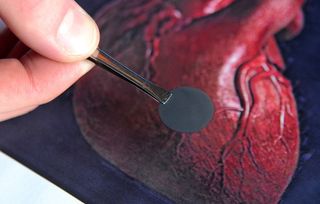Nanopatch Could Reverse Heart Attack Damage

Every heart attack kills part of the heart. It chokes off blood to the nerve and muscle cells that keep the heart beating. But future surgeons might implant a nanopatch that serves as scaffolding to regrow heart cells and resurrect the dead region.
That hope rests upon finding the right nanomaterial recipe to regenerate healthy heart cells. U.S. and Indian researchers took an FDA-approved polymer and mixed in tiny carbon nanofibers to create a surface that encouraged biological cells to grow on it.
The nanopatch — about half the size of a U.S. penny — sat on a glass slide rather than on a beating heart. But such lab success means that animal studies could begin by the end of summer, said Thomas Webster, a biomedical engineer at Brown University. Positive results in animals could lead to clinical trials with human patients.
"We would expect that if someone had a heart attack, you could use imaging tools to determine the size of what part of the heart has been damaged," Webster said. "People could take the nanomaterial and then cut the appropriate shape to match the dimensions of the damage."
Nature's tiny wonders
The secret behind the team's promising results comes from working with materials on the nanoscale, defined as less than 200 nanometers (a human hair is about 100,000 nanometers wide). Having nanoscale features matter because the human body's cells typically interact on such tiny scales, Webster said.
The researchers have seen biological tissues grow faster on nanomaterials time after time. By contrast, today's medical implants don't have nanoscale features — a possible reason why the human body often has trouble accepting them.
Sign up for the Live Science daily newsletter now
Get the world’s most fascinating discoveries delivered straight to your inbox.
"I would argue we could really increase the lifetime of an implant by incorporating the nanoscale features," Webster told InnovationNewsDaily. "That's our hypothesis with every tissue we've worked with, and it's the same with the heart."
Using carbon nanofibers also offered a material that could conduct electricity. That could prove crucial in helping the heart transmit its electrical signals that keep the beat.
Finding the right mix
The recent experiment saw growth of both heart muscle cells (cardiomyocytes) and nerve cells (neurons). Webster's team also managed to grow endothelial cells that encase organs such as the heart, but those results were not detailed in the study that appears in the May 19 issue of the journal Acta Biomaterialia.
"We treated the heart as the multicellular tissue that it is," Webster said. "You can't just regenerate a part of the heart based on one cell type."
Webster's team played with the right mix of carbon nanofibers and poly lactic-co-glycolic acid polymer to encourage the most cell growth. A 75 percent mixture of 200-nanometer-diameter carbon nanofibers led to five times as many heart-tissue cells growing on the surface compared to only having the polymer.
Such results took place after only four hours. The density of neurons on the nanopatch also doubled after four days.
Future treatments
Webster's Brown University group provided the biological expertise for maximizing cell growth, but the nanomaterial engineering expertise came largely from Bikramjit Basu at the Indian Institute of Technology Kanpur. Together, the international team already has eyes on improving the nanopatch for possible use in treating heart attack patients.
Today's surgeons might attach the nanopatch by rolling it up and slipping it through a catheter tube. But tomorrow's surgeons might simply inject a room-temperature liquid that solidifies into a Jell-O substance around the damaged heart area. The liquid would hold the same carbon nanofibers.
Webster even suggested a "'Star Trek'-ish" way for how future medicine might treat patients.
"Down the road, if something like this healing process works, ambulances could carry these materials," Webster said. "If there was a heart attack patient, they could inject right away after doing a chest scan."
This story was provided by InnovationNewsDaily, a sister site to LiveScience.
Most Popular


